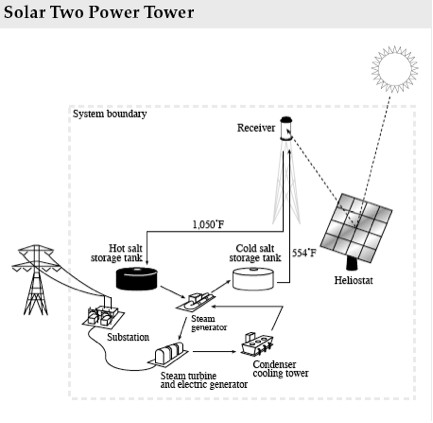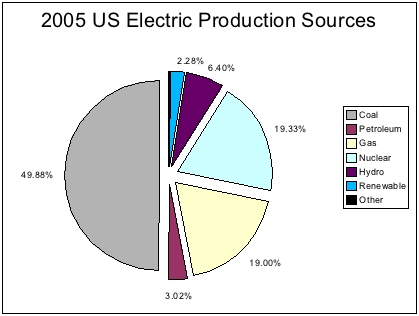Renewable Baseload Energy
Posted on 27 November 2010 by dana1981
A common argument against investing in renewable energy technology is that it cannot provide baseload power - that is, the ability to provide energy at all times on all days. This raises two questions - (i) are there renewable energy sources that can provide baseload power, and (ii) do we even need renewable baseload energy?
Does Renewable Energy Need to Provide Baseload Power?
A common myth is that because some types of renewable energy do not provide baseload power, they require an equivalent amount of backup power provided by fossil fuel plants. However, this is simply untrue. As wind production fluctuates, it can be supplemented if necessary by a form of baseload power which can start up or whose output can be changed in a relatively short period of time. Hydroelectric and natural gas plants are common choices for this type of reserve power (AWEA 2008). Although a fossil fuel, combustion of natural gas emits only 45% as much carbon dioxide as combustion of coal, and hydroelectric is of course a very low-carbon energy source.
The current energy production structure consists primarily of coal and nuclear energy providing baseload power, while natural gas and hydroelectric power generally provide the variable reserves to meet peak demand. Coal is cheap, dirty, and the plant output cannot be varied easily. It also has high initial investment cost and a long return on investment time. Hydroelectric power is also cheap, clean, and good for both baseload and meeting peak demand, but limited by available natural sources. Natural gas is less dirty than coal, more expensive and used for peak demand. Nuclear power is a low-carbon power source, but with an extremely high investment cost and long return on investment time.
Renewable energy can be used to replace some higher-carbon sources of energy in the power grid and achieve a reduction in total greenhouse gas emissions from power generation, even if not used to provide baseload power. Intermittent renewables can provide 10-20% of our electricity, with hydroelectric and other baseload renewable sources (see below) on top of that. Even if the rapid growth in wind and other intermittent renewable sources continues, it will be over a decade before storage of the intermittent sources becomes a necessity.
Renewable Baseload Energy Sources
Of course in an ideal world, renewable sources would meet all of our energy needs. And there are several means by which renewable energy can indeed provide baseload power.
Concentrated Solar Thermal
One of the more promising renewable energy technologies is concentrated solar thermal, which uses a system of mirrors or lenses to focus solar radiation on a collector. This type of system can collect and store energy in pressurized steam, molten salt, phase change materials, or purified graphite.
The first test of a large-scale thermal solar power tower plant was Solar One in the California Mojave Desert, constructed in 1981. The project produced 10 megawatts (MW) of electricity using 1,818 mirrors, concentrating solar radiation onto a tower which used high-temperature heat transfer fluid to carry the energy to a boiler on the ground, where the steam was used to spin a series of turbines. Water was used as an energy storage medium for Solar One. The system was redesigned in 1995 and renamed Solar Two, which used molten salt as an energy storage medium. In this type of system, molten salt at 290ºC is pumped from a cold storage tank through the receiver where it is heated to about 565ºC. The heated salt then moves on to the hot storage tank (Figure 1). When power is needed from the plant, the hot salt is pumped to a generator that produces steam, which activates a turbine/generator system that creates electricity (NREL 2001).

Figure 1: Solar Two Power Tower System Diagram (NREL 2001)
The Solar Two molten salt system was capable of storing enough energy to produce power three hours after the Sun had set. By using thermal storage, power tower plants can potentially operate for 65 percent of the year without the need for a back-up fuel source. The first commercial concentrated solar thermal plant with molten salt storage - Andasol 1 - was completed in Spain in 2009. Andasol 1 produces 50 MW of power and the molten salt storage can continue to power the plant for approximately 7.5 hours.
Abengoa Solar is building a 280 MW solar thermal plant in Arizona (the Solana Generating Station), scheduled to begin operation in 2013. This plant will also have a molten salt system with up to 6 hours worth of storage. The electrical utility Arizona Public Service has contracted to purchase the power from Solana station for approximately 14 cents per kilawatt-hour.
Italian utility Enel recently unveiled "Archimede", the first concentrated solar thermal plant to use molten salts for both heat storage and heat transfer. Molten salts can operate at higher temperatures than oils, which gives Archimede higher efficiency and power output. With the higher temperature heat storage allowed by the direct use of salts, Archimede can extend its operating hours further than an oil-operated solar thermal plant with molten salt storage. Archimede is a 5 MW plant with 8 hours of storage capacity.
The National Renewable Energy Laboratory provides a long list of concentrated solar thermal plants in operation, under construction, and in development, many of which have energy storage systems. In short, solar thermal molten salt power storage is already a reality, and a growing resource.
Geothermal
Geothermal systems extract energy from water exposed to hot rock deep beneath the earth's surface, and thus do not face the intermittency problems of other renewable energy sources like wind and solar. An expert panel concluded that geothermal sources could produce approximately 100 gigawatts (GW) of baseload power to the USA by mid-century, which is approximately 10% of current US generating capacity (MIT 2006). The panel also concluded that a research and development investment of less than $1 billion would make geothermal energy economically viable.
The MIT-led report focuses on a technology called enhanced or engineered geothermal systems (EGS), which doesn't require ideal subsurface conditions and could theoretically work anywhere. installing an EGS plant typically involves drilling a 10- to 12-inch-wide, three- to four-kilometer-deep hole, expanding existing fractures in the rock at the bottom of the hole by pumping down water under high pressure, and drilling a second hole into those fractures. Water pumped down one hole courses through the gaps in the rock, heats up, and flows back to the surface through the second hole. Finally, a plant harvests the heat and circulates the cooled water back down into the cracks (MIT 2007).
Currently there are 10.7 GW of geothermal power online globally, with a 20% increase in geothermal power online capacity since 2005. The USA leads the world in geothermal production with 3.1 GW of installed capacity from 77 power plants (GEA 2010).
Wind Compressed Air Energy Storage (CAES)
Various methods of storing wind energy have been explored, including pumped hydroelectric storage, batteries, superconducting magnets, flywheels, regenerative fuel cells, and CAES. CAES has been identified as the most promising technology for utility-scale bulk wind energy storage due to relatively low costs, environmental impacts, and high reliability (Cavallo 2005). CAES plants are currently operational in Huntorf, Germany (290 MW, since 1978) and Macintosh, Alabama (110 MW, since 1991). Recently this type of system has been considered to solve the intermittency difficulties associated with wind turbines. It is estimated that more than 80% of the U.S. territory has geology suitable for such underground storage (Gardner and Haynes 2007).
The Iowa Stored Energy Park has been proposed to store air in an underground geologic structure during time periods of low customer electric demand and high wind. The project is hoping to store a 20 week supply of compressed air and have approximately 270 MW of generating capacity. The project is anticipated to be operational in 2015.
A similar system has been proposed to create a wind turbine-air compressor. Instead of generating electricity, each wind turbine will pump air into CAES. This approach has the potential for saving money and improving overall efficiency by eliminating the intermediate and unnecessary electrical generation between the turbine and the air compressor (Gardner and Haynes 2007).
Pumped Heat Energy Storage
Another promising energy storage technology involves pumping heat between tanks containing hot and cold insulated gravel. Electrical power is input to the system, which compresses/expands air to approximately 500°C on the hot side and -150°C on the cold side. The air is passed through the two piles of gravel where it gives up its heat/cold to the gravel. In order to regenerate the electricity, the cycle is simply reversed. The benefits of this type of system are that it would take up relatively little space, the round-trip efficiency is approximately 75%, and gravel is a very cheap and abundant material.
Spent Electric Vehicle (EV) Battery Storage
As plug-in hybrids and electric vehicles become more commonplace, the possibility exists to utilize the spent EV batteries for power grid storage after their automotive life, at which point they will still have significant storage capacity. General Motors has been examining this possibility, for example. If a sufficiently large number of former EV batteries could be hooked up to the power grid, they could provide storage capacity for intermittent renewable energy sources.
Summary
To sum up, there are several types of renewable energy which can provide baseload power. Additionally, intermittent renewable energy can replace dirty energy sources like coal, although it currently requires a backup source such as natural gas which must be factored into the cost of intermittent sources. It will be over a decade before we can produce sufficient intermittent renewable energy to require high levels of storage, and there are several promising energy storage technologies. One study found that the UK power grid could accommodate approximately 10-20% of energy from intermittent renewable sources without a "significant issue" (Carbon Trust and DTI 2003). By the time renewable energy sources begin to displace a significant part of hydrocarbon generation, there may even be new storage technologies coming into play. The US Department of Energy has made large-scale energy storage one if its research priorities, recently awarding $24.7 million in research grants for Grid-Scale Rampable Intermittent Dispatchable Storage.
This post is the Intermediate version (written by Dana Nuccitelli [dana1981]) of the skeptic argument "Renewables can't provide baseload power".































 Arguments
Arguments























 0
0  0
0 There is no such correlation.
There is no such correlation.

 Source:
http://montaraventures.com/blog/2006/10/09/how-does-the-us-produce-electricity/
So, we need a future that is different. Based on the statement that 60% of energy consumption is baseload, we should aim for for a fossil free future that looks something like this:
coal 0%
nuclear 30%
petroleum 0%
hydro 5%
renewable 65%
gas backup (normally not used, but available): 20%
This will require an intermediate stage where gas takes on a larger role as we get off of coal and ramp up renewables and supporting technologies.
Source:
http://montaraventures.com/blog/2006/10/09/how-does-the-us-produce-electricity/
So, we need a future that is different. Based on the statement that 60% of energy consumption is baseload, we should aim for for a fossil free future that looks something like this:
coal 0%
nuclear 30%
petroleum 0%
hydro 5%
renewable 65%
gas backup (normally not used, but available): 20%
This will require an intermediate stage where gas takes on a larger role as we get off of coal and ramp up renewables and supporting technologies.







Comments